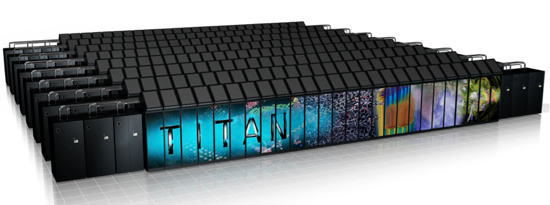
Every year, the Top 500 list of the world’s fastest supercomputers is released. A list filled with machines containing tens of thousands of nodes and capable of cranking out enough petaflops per second to make your head spin.
And, of course, this list is absolutely dominated by machines powered by Linux.
This is awesome. But, really, we all know this. Let’s dig a little deeper into these Goliath computers that will, someday, become sentient and rise up against their human creators.
Let’s start with the #2 ranked supercomputer – The Titan.
This Cray-built beast of a computer lives in Tennessee at the Oak Ridge National Laboratory and takes up 4,352 square feet. Which, for those of you who are curious, is roughly 6.8 times the size of my first apartment – and approximately infinity times larger than the kitchen in that apartment (give or take a foot).
Want to build this computer for yourself? No problem. It uses an off-the-shelf AMD Opteron 16 core, 2.2 GHz CPU. 35,040 of them. Which begs the question, what sort of actual performance do you get from more than 560,000 CPU cores? 17.5 million petaflops. That’s what you get.
So what does that actually mean? What can you do with 17.5 million petaflops that you can’t do with a fancy, quad core i7 desktop PC?
Well, for starters, it can run a particle simulator that can handle things way down at the quantum level (specifically the Large-scale Atomic/Molecular Massively Parallel Simulator, aka “LAMMPS”). OK. That’s cool I guess. Definitely produces some crazy–looking videos. But I just don’t run quantum level particle simulations all that often. I need to know how well this sucker runs Portal.
The AMD Phenom II (quad core), clocked at 3.40 GHz – a very respectable desktop CPU – can run Portal (at 1600×900) at roughly 59 frames per second. That particular CPU can crank out something in the ballpark of 39 gigaflops.
Now. Assuming the only factor that contributes to the frame-rate of a game is the number of Floating-point Operations Per Second (FLOPS) – that means that Portal, when running on the Titan, should be able to hit 26,474,358 frames per second.
“But, Bryan!” I hear you say. “They can’t possibly have a screen nice enough to showcase that sort of awesomeness!”
Au contraire, mon frère! Those crazy kids down in Tennessee have built EVEREST (the “Exploratory Visualization Environment for Research and Technology”) – which includes a 33-foot wide, 37 megapixel, stereoscopic 3D screen.
You know. For research. Wink, wink, nudge, nudge. Hold on a moment. I’m going to go let my wife know that I need a 60” 4K TV set. Because science and particles and stuff.
OK, let’s slam on the brakes and drop down the list a bit to the #21 ranking supercomputer in the world – NASA’s Pleiades.
Now, I say “slam on the brakes,” but this SGI-built, SUSE-powered beauty still manages to push through 1.5 petaflops like a hot knife through butter (we’re talking room temperature butter … not that stuff from the fridge that can’t be cut with a laser cannon and causes you to slaughter your poor, defenseless toast).
In other words, it probably runs Portal fairly well. But what, pray tell, is NASA using such a rig for?
To do amazing NASA space stuff. That’s what.
 The Pleiades is involved in the search for Earth-like planets (the Kepler Mission). For its role in that, most stellar, project the Pleiades receives high-resolution images of more than 200,000 stars. It then calculates the size and location of the planets orbiting those stars. It does this every half hour. No coffee break.
The Pleiades is involved in the search for Earth-like planets (the Kepler Mission). For its role in that, most stellar, project the Pleiades receives high-resolution images of more than 200,000 stars. It then calculates the size and location of the planets orbiting those stars. It does this every half hour. No coffee break.
Every. Half. Hour. It takes me longer than that to drive to my closest Trader Joe’s.
To date, it has discovered 1,235 planets. Five of them possibly “Earth-like” (similar size and within a habitable orbit around their star). When it gets bored of being off-the-charts awesome, sometimes Pleiades likes to run simulations on the formation of the Milky Way Galaxy. You know, just to kinda … clear its head.
We’ve just talked (briefly) about two of the coolest computers on the planet. And there are 498 more on that mind-bending list. I’ll leave you with one final thought:
The total number of petaflops produced by all of the supercomputers on this list, combined, is roughly 274 – with roughly half of all the total speed being generated by the top 20 computers.
I’m sure there’s an allegory in there somewhere about class inequality and the French Revolution, but all I keep thinking about is the (obviously imminent) human-robot war.
Read more of Bryan Lunduke’s columns, here:
The Battle of the OpenStack Distros Begins (Bring Popcorn)
Why Linux Works for Government
Why Arguing That Windows is Better Than Linux Makes You Look Silly


